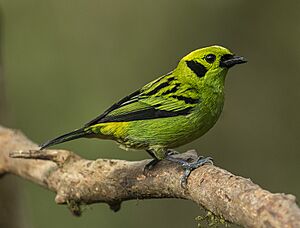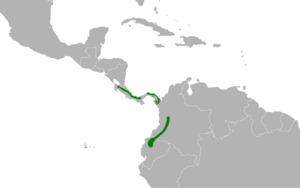Emerald tanager facts for kids
Quick facts for kids Emerald tanager |
|
|---|---|
 |
|
| Conservation status | |
| Scientific classification | |
 |
|
| Distribution | |
| Synonyms | |
|
The emerald tanager (Tangara florida) is a beautiful species of bird that belongs to the tanager family. These colorful birds live in parts of Central and South America, including Colombia, Costa Rica, Ecuador, and Panama. They were first described by two English bird experts, Philip Sclater and Osbert Salvin, in 1869.
Emerald tanagers are medium-sized birds, about 10.6 to 13 centimeters (4 to 5 inches) long. They weigh around 18 to 20.5 grams (0.6 to 0.7 ounces). You can easily spot them by their bright green feathers. They also have black stripes on their back and wings. A black patch near their ears and a black beak are also key features. Their head and rump often have bright yellow spots. Female emerald tanagers look a bit different. They are usually less bright and have yellow-green on their heads instead of yellow.
These birds mostly live in warm, wet lowland forests. They also like mountain evergreen forests and secondary forests. You can find them at heights from 500 to 900 meters (1,600 to 3,000 feet) above sea level. Sometimes, they live as low as 100 meters (330 feet) or as high as 1,200 meters (3,900 feet). Emerald tanagers eat both plants and insects. They mainly enjoy fruit, flowers, and flower buds. They also eat arthropods (like insects and spiders).
Emerald tanagers build cup-shaped nests from moss. They usually lay two eggs at a time. In Costa Rica, they breed from March to May. In Colombia, their breeding season is from January to April. The International Union for Conservation of Nature (IUCN) lists the emerald tanager as a species of least concern. This means they are not currently in great danger. However, their homes are being destroyed, which is a threat to them.
Contents
About the Emerald Tanager's Name
The emerald tanager was first named Calliste florida in 1869. This name was given by English bird experts Philip Sclater and Osbert Salvin. They studied a female bird from Costa Rica.
The name of the bird's group, Tangara, comes from a word in the Tupí language. It means "dancer." The second part of its scientific name, florida, comes from the region of Florida. The International Ornithologists' Union (IOU) officially calls this bird the emerald tanager.
The emerald tanager is one of 27 species in the Tangara group. This group of tanagers lives in the Neotropics. Scientists have studied their mitochondrial DNA. They found that the emerald tanager is related to several other colorful tanagers. These include the blue-whiskered tanager and the silver-throated tanager. The emerald tanager is most closely related to the silver-throated tanager.
Most experts agree that there is only one type of emerald tanager. However, some think that birds from eastern Panama, Colombia, and northwestern Ecuador might be a slightly different kind. They call this possible subspecies T. f. auriceps.
What Does the Emerald Tanager Look Like?
The emerald tanager is a medium-sized bird. It is about 10.6 to 13 centimeters (4 to 5 inches) long. It weighs between 18 and 20.5 grams (0.6 and 0.7 ounces). Males and females look quite similar. However, females are usually a bit duller in color. Their heads have yellow-green feathers instead of bright yellow.
This bird might sometimes be confused with the glistening-green tanager. But the emerald tanager's colors are not as strong. It also looks a bit like the blue-whiskered tanager. You can tell them apart because the blue-whiskered tanager has a black face and throat. It also has turquoise cheeks.
Adult male emerald tanagers are mostly bright, light green. They have black stripes on their upper body. The area around their eyes and beak is black. The patch near their ears is also black. The back of their head is dark yellow. The rest of their head and a band on their neck are yellowish-green. Their upper back is black, but their lower back and rump are dark yellow. Their wings are a mix of black and green.
The underside of the bird is mostly light green. The middle of their belly and the feathers under their tail are light yellow. Their eyes are brown, their beak is black, and their feet are bluish-gray. Young emerald tanagers look like adult females. Very young birds are much duller in color. Young males get feathers like adult females after their first molt (when they shed old feathers). They get their full adult male feathers after a second molt, usually after their first breeding season.
What Sounds Do They Make?
The emerald tanager makes a sharp "chip" or "tsip" sound. They might repeat this sound. Sometimes, it speeds up into a quick twitter. Their song is a series of loud "cheet" or "chiip" notes.
Where Do Emerald Tanagers Live?
The emerald tanager lives from southern Costa Rica down to northern Ecuador. This includes Panama and Colombia. They might also be found in the very southern part of Nicaragua. There are two separate groups of these birds. They are divided by an area between Panama and the San Juan River.
Across their home range, emerald tanagers are most common at heights of 500 to 900 meters (1,600 to 3,000 feet). But they can live as high as 1,200 meters (3,900 feet) in Ecuador. In Colombia, they can be found as low as 100 meters (330 feet). The average height they live at is higher in the north and lower in the south.
Emerald tanagers live in humid lowland forests. They also like mountain evergreen forests and secondary forests. They usually stay in the canopy (the top layer of trees). They rarely go down to the forest floor. Sometimes, they are seen in fruit trees or bushes next to forests. They prefer places with lots of trees over open areas.
How Emerald Tanagers Live
The average time for a generation of emerald tanagers to grow up and have their own young is about 3.26 years.
What Do They Eat?
The emerald tanager is an omnivore. This means it eats both plants and animals. It mainly eats fruit. It also adds arthropods (like insects), flowers, and flower buds to its diet. In Costa Rica, they eat more arthropods during the breeding season. Some of their favorite fruits come from trees like Miconia, Coussapoa, Cecropia, and Ficus.
Emerald tanagers might look for food alone or in pairs. Sometimes, they form small groups of 3 to 7 birds. They often join larger mixed-species flocks. These flocks include other tanagers, honeycreepers, and warblers. They are very active when they forage. They sometimes move around excitedly while looking for food.
They usually pick fruits from branches. They find insects by searching in moss on tree branches. Sometimes, they even tear moss apart to catch their prey. These birds have also been seen eating army ants when they swarm.
Reproduction and Life Cycle
The breeding season for emerald tanagers changes depending on where they live. In Costa Rica, they breed from March to May. In Colombia, they breed from January to April. They build their nests on moss-covered branches high above the ground. Nests can be from 1.5 to 12 meters (5 to 39 feet) high.
Their nests are cup-shaped and made of moss. Female emerald tanagers lay two eggs in each clutch. Bird pairs have been seen bringing insects and fruit back to their nests for their young.
Conservation Status
The emerald tanager is listed as a species of least concern by the International Union for Conservation of Nature (IUCN) on the IUCN Red List. This is because they have a large enough home range. Also, their population has not dropped significantly.
However, the number of emerald tanagers is currently decreasing. Scientists believe there are between 40,000 and 499,999 mature birds. The biggest threat to them is habitat destruction. This means their forest homes are being cut down. Deforestation is already causing problems for them in some areas. Habitat destruction is especially bad in places with steep changes in height. This can cause groups of birds to become separated. This also reduces their genetic diversity, which is the variety in their genes.



